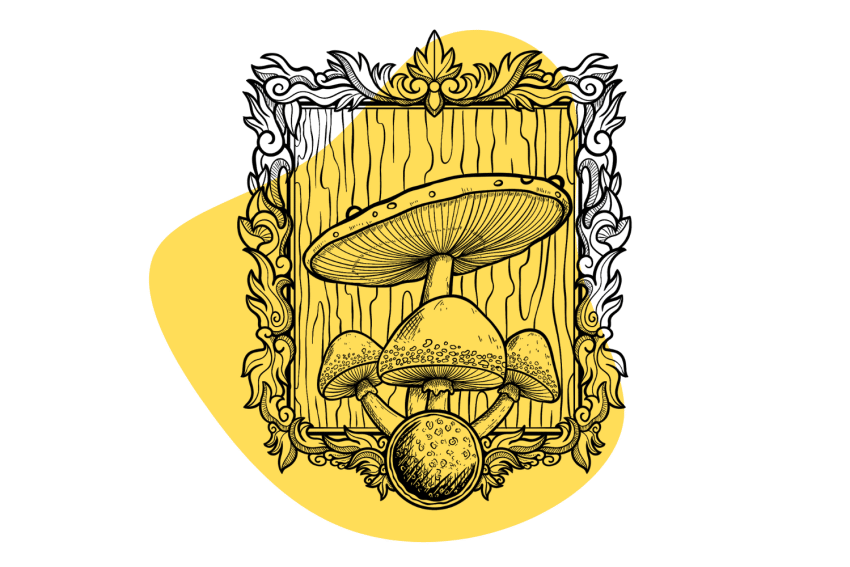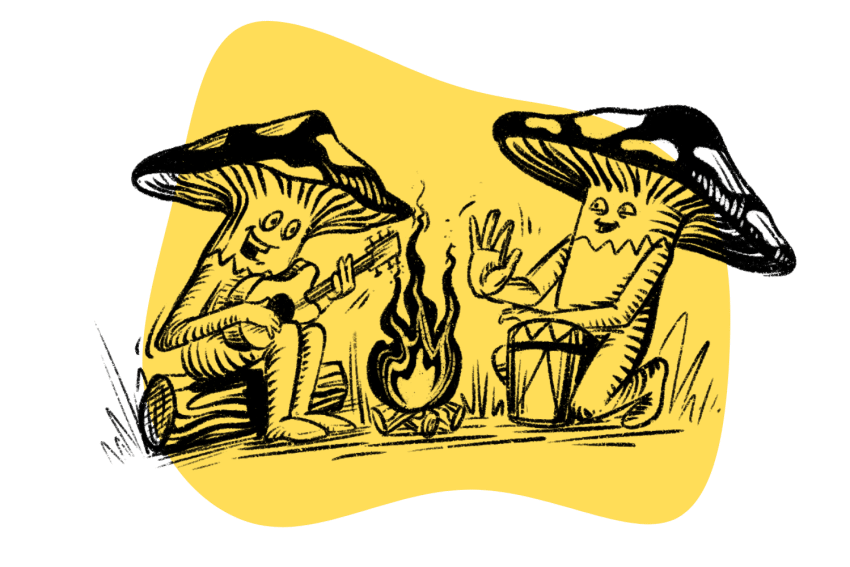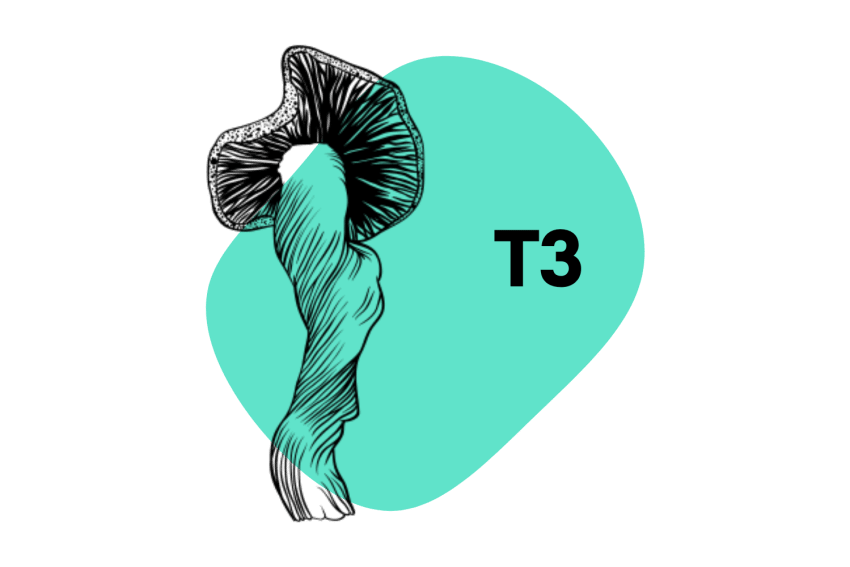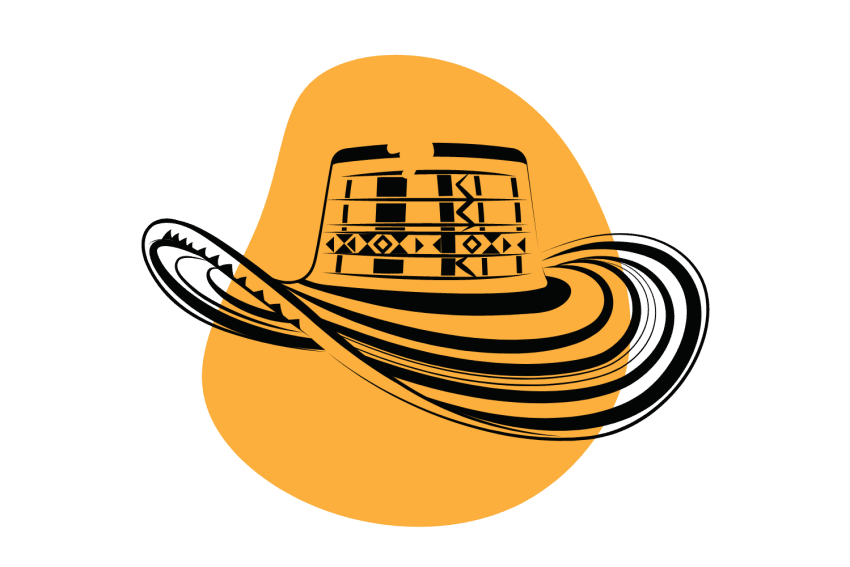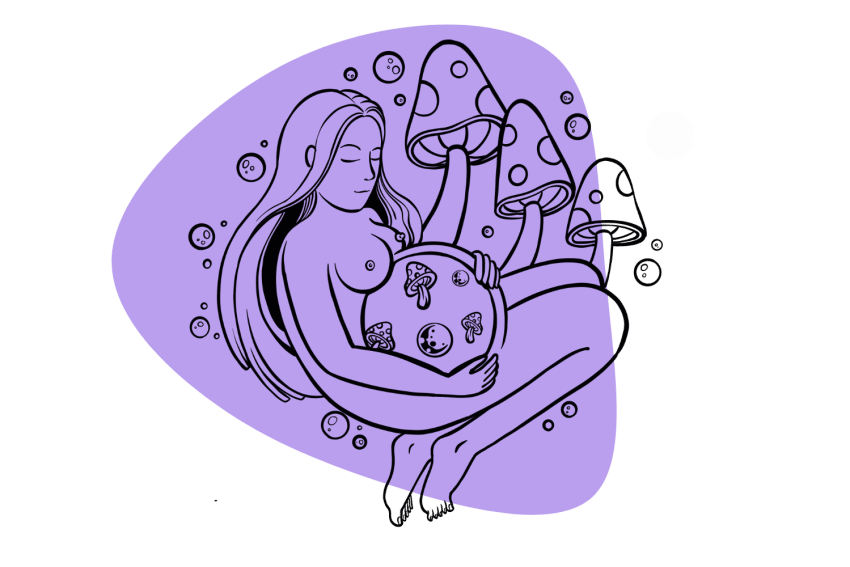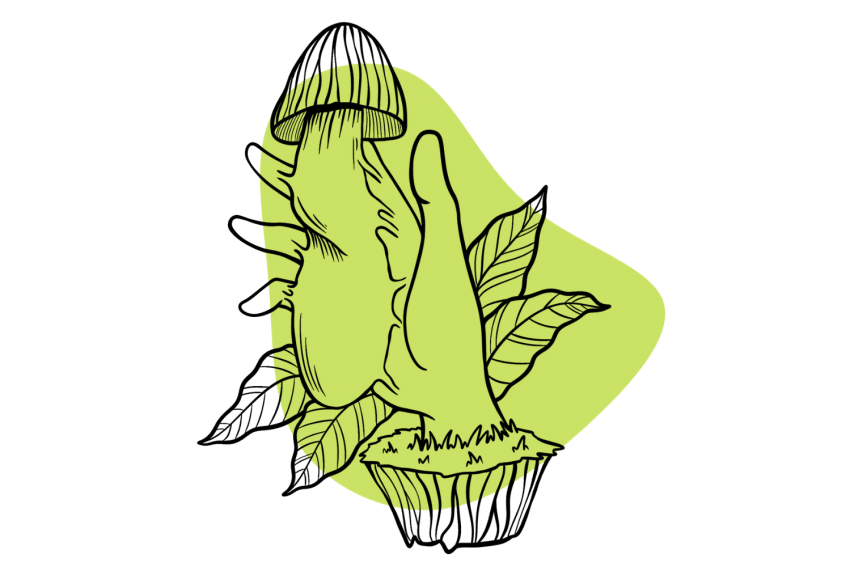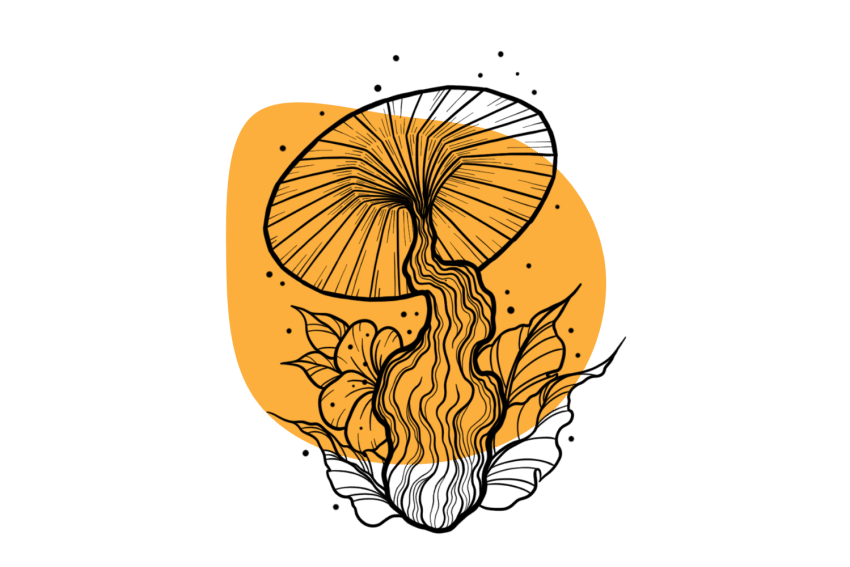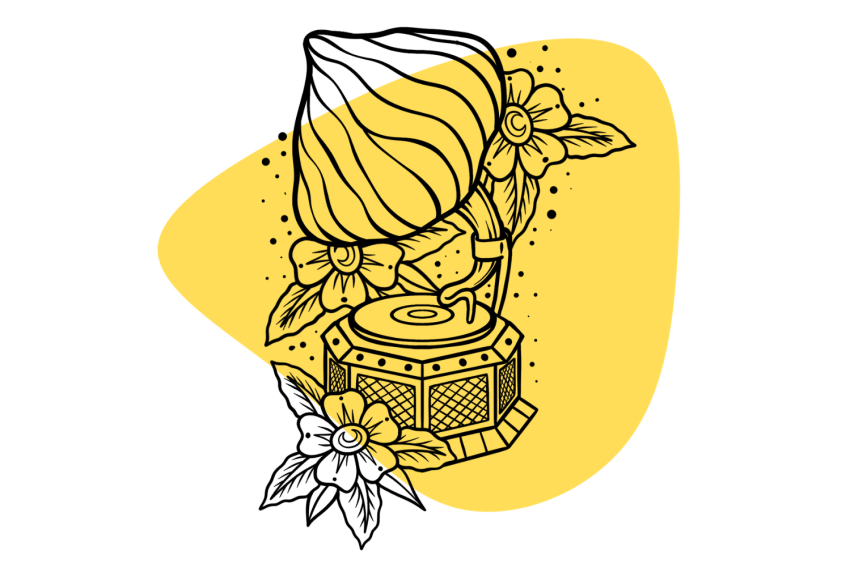Panaeolus cinctulus: A “Poisonous” Species of Psilocybin Mushroom
Once believed to be deadly poisonous, Panaeolus cinctulus is a Mottlegill that most foragers steer clear of…
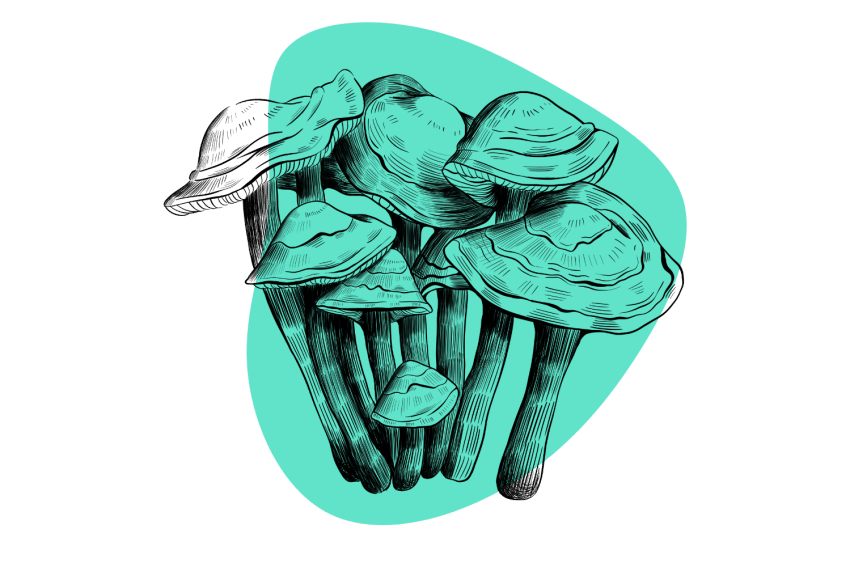
Panaeolus cinctulus is a peculiar species in the Panaeolus genus that produces the psychedelic compounds psilocybin and psilocin.
For decades, people assumed it was poisonous.
This small mushroom species is known commonly as the “Banded Mottlegill” because of the bands of color on its caps and gills. It’s also known as the “Weed Panaeolus” because it’s often found in vegetable and mushroom beds growing alongside edible varieties of Agaricus.
Panaeolus cinctulus has a peculiar history and is relatively unknown among the psychedelic mushroom community. So, is this common shroom worth exploring, or is it better left in nature?
In this article, we explore everything you need to know about Panaeolus cinctulus, including its history, potency, information on dosing (with dosage calculator), identification and look-alikes, cultivation, and legality.
What Is Panaeolus cinctulus?
Panaeolus cinctulus is a species in the genus Panaeolus. For decades, this species has been classified as poisonous, but it actually contains the psychedelic tryptamines psilocybin and psilocin. This is one of very few Panaeolus species that produces these compounds.
Panaeolus cinctulus goes by many different common names. It’s known as the Banded Mottlegill in most countries but is also called the Girdled Panaeolus, Weed Panaeolus, Poison Panaeolus, and “Red Caps.”
Unlike the Psilocybe genus, not all Panaeolus mushrooms are psychedelic. Many are classified inedible and potentially toxic. This species isn’t particularly potent, and due to the mushroom’s small size, collecting enough for a psychedelic dose is quite the challenge.
These mushrooms are around 2–10 centimeters tall with caps 1.5–5.5 centimeters in diameter. They have smooth, brown caps when moist and black caps when wet. They usually have a darker outer band — hence the common name “Banded Mottlegill.” The stems are thin and brittle with a reddish-brown to white coloration.
Related Guides: Magic Mushrooms 101
The History of Panaeolus cinctulus
Panaeolus cinctulus has an unusual history. For decades, this species was believed to be deadly toxic and was blamed for numerous mushroom poisonings. It’s still labeled as poisonous and inedible in most field guides, mushroom ID guides, and mobile applications.
1. The Discovery & Classification of Panaeolus cinctulus
Panaeolus cinctulus was discovered and recorded scientifically in the “United Kingdom Species Inventory” by mycologists Miles Joseph Berkeley and Christopher Edmund Broome in 1860 [1].
The first sample was discovered growing on a pasture just outside Apethorpe — a village close to Peterborough in the United Kingdom. Berkeley and Broome classified the species as “Panaeolus subbalteatus” — “subbalteatus” coming from the Latin words “sub” (somewhat) and “balteat” (girdled).
The species retained this classification for several years until it was defined as a variant of the species — “Panaeolus subbalteatus” (var. cinctulus).
The name we use to describe the species today (Panaeolus cinctulus) didn’t come about until sometime in the late 1970s.
The American mycologist Paul Stamets argued for its separation from the Panaeolus subbalteatus species. The difference in habitat, morphology, and spore dimensions make it taxonomically different from Panaeolus subbalteatus, placing it as an individual species of Panaeolus rather than a variant of P. subbalteatus.
2. How Panaeolus cinctulus Became the “Poison Panaeolus”
In 1916, the American mycologist William Murrill rediscovered the Panaeolus cinctulus species while working at the New York Botanical Gardens. Murril reported that a local cultivator of Agaricus campestris (field mushrooms) served her family members mushrooms from her beds “with nearly fatal results [2].”
The cultivator had picked a bunch of what we now know as Panaeolus cinctulus that had colonized the substrate along with the culinary Agaricus mushrooms. Murrill named the species “Panaeolus venenosus,” believing he’d discovered a new poisonous mushroom species.
In his report, he warned that poisonous mushrooms may develop from commercial Agaricus campestris spawn, and cultivators must be vigilant not to eat or sell any mushrooms that look different from the white-capped culinary mushrooms.
Thanks to William Murrill, the mushroom we know as Panaeolus cinctulus gained the common name “Poison Panaeolus,” — sparking fear among mushroom cultivators and foragers across America.
Around this time, the species developed another one of its common names — the “Weed Panaeolus.” It developed this name because it started to appear frequently in commercially cultivated beds of Agaricus bisporus (button mushrooms) and Agaricus campestris (field mushrooms).
Over the coming years, Panaeolus cinctulus was blamed for a number of wild mushroom poisonings. Reports of Panaeolus cinctulus poisonings (then Panaeolus subbalteatus) can be found as late as the 1970s, with one famous hospitalization case coming from the Poison Unit at the Royal Infirmary in Edinburgh, Scotland [3].
The patient reported nausea, vomiting, difficulty concentrating at work, and a “sharpening of the senses” — effects associated with a low-dose psilocybin experience.
3. The Discovery of Psilocybin in Panaeolus cinctulus
Panaeolus cinctulus’ hallucinogenic properties have been known for quite some time. You can find reports of delirium and hallucinations in some of the poison reports of the early 1900s. These effects were reported as a result of the poisonings, and research into why these hallucinations occurred wasn’t pursued.
It’s unclear who exactly discovered the presence of psilocybin in the Panaeolus cinctulus species, but the famed mycologist Paul Stamets wrote about its psychedelic properties in his book Psilocybin Mushrooms of the World (1996).
The Potency & Effects of Panaeolus cinctulus
Despite Panaeolus cinctulus being blamed for multiple poisonings, this mushroom appears to be relatively safe to consume. However, it takes large amounts to experience any psychedelic effects since there are such low levels of psilocybin present in the shrooms.
We’re unsure of the exact concentrations of psychedelic tryptamines in Panaeolus cinctulus mushrooms because there’s a lack of detailed reports on its chemical makeup. However, we estimate this species can produce around 0.20% total tryptamines — 0.05% to 0.15% psilocybin/psilocin (dry weight).
Most psychonauts who have tripped on Panaeolus cinctulus mushrooms claim that it takes at least seven grams of dry mushrooms to experience any sort of psychedelic trip.
The effects of psilocybin include:
- Altered mood
- Altered perception of time
- Changes in perception of self
- Enhanced creativity
- Euphoria
- Increased empathy
- Increased introspection
- Increased sociability
- Intense emotions
- Spiritual (mystical) experiences
- Visual & auditory hallucinations
Comparing The Potency of 20 Psychedelic Mushrooms
There are hundreds of psychedelic mushroom species on Earth. Here are the 20 most potent species available today.
Panaeolus cinctulus comes in at the 21 or 22 position (tied with Psilocybe argentipes) so it didn’t quite make the top 20 list.
Related Topics: What’s the Strongest Magic Mushroom (Strains & Species) | What’s the Average Magic Mushroom Potency?
Dosage: Panaeolus cinctulus Mushrooms
Due to the low levels of psilocybin present in Panaeolus cinctulus mushrooms, you have to consume large quantities to experience any psychedelic effects. This species is more suited for microdosing than psychoactive dosing.
These mushrooms are incredibly small. A single dried mushroom weighs as little as 0.1 grams, meaning several must be harvested or cultivated to induce a psychedelic trip. Some report that over 100 wild mushrooms are needed to induce any sort of effect.
If you’re looking for a magic mushroom for tripping, we recommend going in search of Psilocybe semilanceata (Liberty Caps), Psilocybe cubensis (Cubes), or Psilocybe cyanescens (Wavy Caps). One, some, or all of these species likely grow in your region. If they are hard to come by in the wild, P. cubensis can be easily cultivated at home with minimal equipment, time, or cultivation experience.
Here are the rough doses in dry weight for Panaeolus cinctulus:
- Low Dose: 3–4 grams
- Medium Dose: 4–6 grams
- High Dose: 6–8 grams
- Heroic Dose: 8 grams or more
Magic Mushroom Dosage Calculator
Double-check the potency of the DXM you’re using, and look for the addition of other compounds such as acetaminophen which can cause severe liver-toxic side-effects at this dose.
Microdosing Panaeolus cinctulus
The low levels of the psychedelic tryptamine psilocybin make Panaeolus cinctulus a potential candidate for microdosing. The difficulties associated with consuming high enough doses for a psychedelic experience may be beneficial to those who want to microdose psilocybin.
A microdose is a non-psychoactive dose of psilocybin. It’s a dose low enough that it won’t induce any psychedelic effects but high enough to receive the potential physical and mental benefits of psilocybin. Users may feel light stimulation and subtle feelings of euphoria after a microdose, but they won’t experience any visual hallucinations.
Studies suggest that microdosing psilocybin mushrooms such as Panaeolus cinctulus can improve mood, focus, and cognitive performance [4]. People with depression, anxiety, ADHD, or stress issues may benefit from microdosing.
A microdose is typically 1/10th of a psychoactive dose. This works out to be around 3-10 mg of combined psilocybin and psilocin. In the case of Panaeolus cinctulues, a microdose works out to roughly 0.30-1.50 grams of dried mushrooms. However, it’s best to test the psilocybin levels in the shrooms before assuming potency.
You can test the psilocybin levels in magic mushrooms by using a home tryptamine test such as the Miraculix Psilocybin Lab Test Kit.
Where to Find Panaeolus cinctulus Mushrooms In the Wild
Panaeolus cinctulus mushrooms are relatively widespread. Like most species of Panaeolus, this is a saprobic species, meaning it obtains nutrients by decomposing organic matter.
They can be found in several countries across the globe and grow in compost, mulch, vegetable beds, lawns, and areas of nutrient-rich pasture. They’re often found growing directly from livestock manure, but they grow more prolifically in organic matter and nutrient-rich grounds.
These mushrooms grow in similar habitats to Psilocybe semilanceata (Liberty Caps). They often grow close by but are usually overlooked by psychedelic mushroom foragers who don’t know the species or assume they’re inedible and inactive.
Related: Guide to Foraging Wild Magic Mushrooms
What Countries Do Panaeolus cinctulus Mushrooms Grow In?
This species can grow worldwide in a variety of climates, from temperate to subtropical regions in the Northern and Southern Hemispheres.
Panaeolus cinctulus grows wild in these countries:
- Argentina
- Australia
- Brazil
- Canada
- Chile
- China
- Denmark
- Finland
- France
- Germany
- India
- Iran
- Israel
- Italy
- Japan
- Mexico
- Netherlands
- New Zealand
- Norway
- Poland
- Portugal
- Russia
- South Africa
- Spain
- Sweden
- Thailand
- Turkey
- Ukraine
- United Kingdom
- United States
This list isn’t exhaustive. Panaeolus cinctulus has been reported to grow in the countries listed above — it likely grows in many more, but official documentation of its presence is limited.
How to Identify Panaeolus cinctulus
Panaeolus cinctulus can be difficult to identify in the wild. It has several look-alikes from a variety of different mushroom species. Many species within the Panaeolus genus are almost impossible to tell apart without a microscope.
You must know exactly how to identify Panaeolus cinctulus with 100% certainty before searching for the species. Never eat a mushroom if you’re unsure of its identity.
Here are the physical characteristics of Panaeolus cinctulus:
1. Mushroom Caps
The caps of Panaeolus cinctulus are 1.5 to 5.5 centimeters in diameter. They’re convex (outwardly rounded) when young, campanulate (bell-shaped) when mature, and flat (regular and uniform) when sporulating. They’re orange to cinnamon brown with a dark brown rim around the margin.
2. Gills
The gill attachment is adnate (widely attached to the stipe), closely packed, and slightly swollen at the center. They are dark brown to black and mottled due to the sporadic release of spores from the basidia. The edges remain whitish when young and become black when mature — gently split the cap to see this.
3. Stipe (Stem)
The stipes of Panaeolus cinctulus are 1 to 4 millimeters thick and 2 to 10 centimeters long. They are brittle, hollow, and fibrous. When split, long fibrous strands can be noted. They are reddish-brown with white tones, darkening towards the base.
4. Spores
The spore print of Panaeolus cinctulus mushrooms is black. The spores are “lemon-shaped” from the side view and subellipsoid from the face view.
Dimensions: 11.5-14 by 7.5-9.5 µm (micrometers).
The basidia (spore-bearing structures) are 2 and 4 spored. Pleurocystidia are absent, and cheilocystidia are variable in form — mostly pear-shaped and 14-21 by 3-7 µm (micrometers).
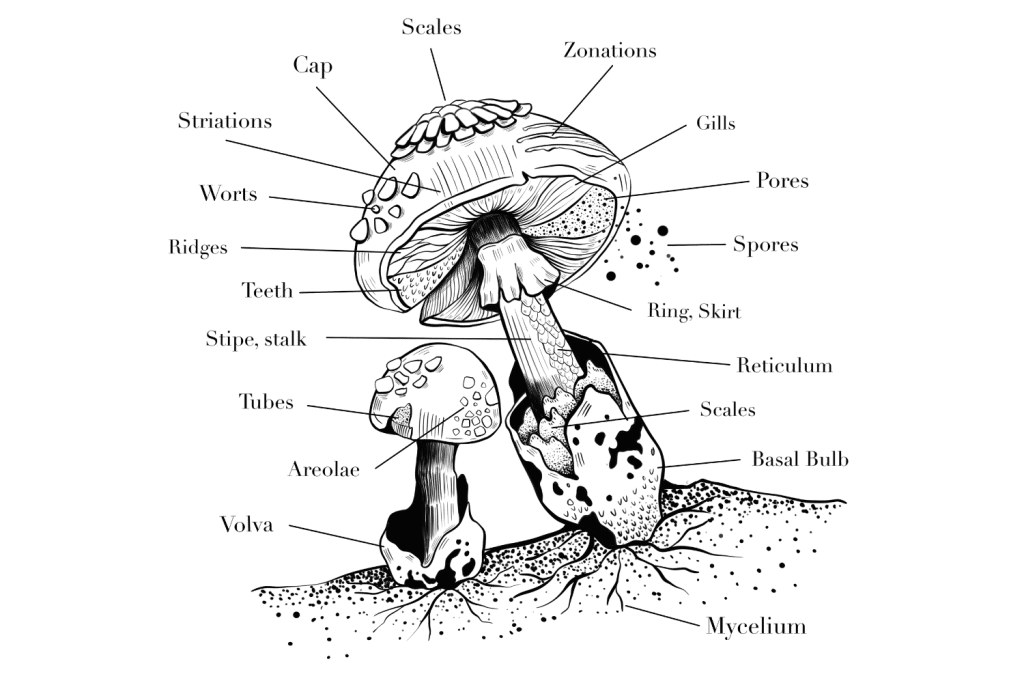
Panaeolus cinctulus Look-Alikes
Panaeolus cinctulus has several look-alikes that share a similar appearance and habitat. You should know how to identify these look-alike species and determine which ones are present in your area before you search for P. cinctulus mushrooms.
A field guide for your local area will help you find out which similar-looking species are present in your region and how to identify them.
Here are a few commonly misidentified species:
1. Panaeolus foenisecii (Haymaker/ Lawn Mower’s Mushroom)
Panaeolus foenisecii is a common species of Panaeolus that’s commonly known as the Haymaker or Lawn Mower’s mushroom. It regularly appears on freshly cut lawns and recently grazed pastures. This mushroom shares several similarities with Panaeolus cinctulus and can be misidentified by the inexperienced forager.
These mushrooms are of a similar size and have hay-colored caps and thin, brown stems. The gills of both species are dark brown and mottled. They grow in similar habitats and can be found in the same countries.
Panaeolus foenisecii doesn’t have the same banded pattern on the caps as P. cinctulus, but it can be difficult to distinguish the two when moist or wet as the caps take on almost identical coloration.
2. Panaeolus papilionaceus (Petticoat Mottlegill)
Panaeolus papilionaceus grows in grassy areas of pasture and lawns. It grows alongside Panaeolus cinctulus in many of the same regions. They have medium-sized brown caps with distinct grooves or radial lines rather than “bands.” However, when wet, they can develop a darker band around the lower portion of the cap.
These two species share the same habitat and look very similar, but the conical cap shape, dark brown stipes, and reminisce of a partial veil on the cap rims can be used to determine P. papilionaceous.
3. Panaeolus subbalteatus (Banded Mottlegill)
Panaeolus subbalteatus is a very close relative of Panaeolus cinctulus. In fact, the cinctulus species was initially classified as P. subbalteatus and later as a species variation. Both share several similarities and are difficult to tell apart, even for experienced mycologists.
Many people still believe these two species are the same, and most guides don’t distinguish between them because they are so similar. You’ll often see the species listed in field guides in this format: “Panaeolus subbalteatus/Panaeolus cinctulus.”
Very subtle differences distinguish P. subbalteatus from P. cinctulus, such as cap size, coloration, and spore structure. Luckily, both species contain similar psychedelic tryptamine levels, so there’s little risk if the species are confused with each other.
4. Galerina marginata (Funeral Bell)
Galerina marginata — commonly known as the Funeral Bell — is a highly toxic mushroom that can be confused for Panaeolus cinctulus by the inexperienced forager.
These mushrooms contain the same deadly amatoxins found in species such as Amanita phalloides (the Deathcap). If ingested, this species can cause severe stomach upset, nausea, vomiting, and, in worse cases, organ failure and death.
Galerina marginata mushrooms have small to medium-sized caps that are conical or bell-shaped. They have brown caps that can become darker around the rim as they lose or take on moisture. The gills are brown and have a distinct annulus (ring) on the stipe.
This species is similar to Panaeolus cinctulus, but several differences can be identified in the field. All foragers should learn how to identify this deadly mushroom to avoid it.
5. Conocybe filaris (Fool’s Conecap)
Conocybe filaris — commonly known as the Fool’s Conecap — is a small, brown mushroom that grows on decaying organic matter in woodlands and grassy areas. It resembles Panaeolus cinctulus but can be distinguished from its present annulus, light-colored stipes, and creamy, rust-colored gills.
This species is toxic, and if large enough quantities are consumed, the individual may experience severe stomach discomfort, nausea, and vomiting. The danger with this species is its “delayed effect.” Often, an individual who has consumed these mushrooms seemingly recovers but later relapses with digestive dysfunctions and, in worse cases, liver and/or kidney failure.
The forager should educate themselves about this species if it’s present in their region. Learning how to identify its defining features will ensure it’s not confused with Panaeolus cinctulus or any other similar-looking edible or psychedelic species.
Can You Grow Panaeolus cinctulus At Home?
Known by many as the “Weed Panaeolus,” this species is famed for growing like a “weed” in mushroom and vegetable beds. It’s resistant to contamination and is an aggressive colonizer. The mycelium colonizes substrate quickly and efficiently, often out-competing other fungi that may be present.
These characteristics make Panaeolus cinctulus relatively easy to cultivate.
This species can be cultivated indoors and outdoors (if the climate is appropriate for growth) using simple techniques.
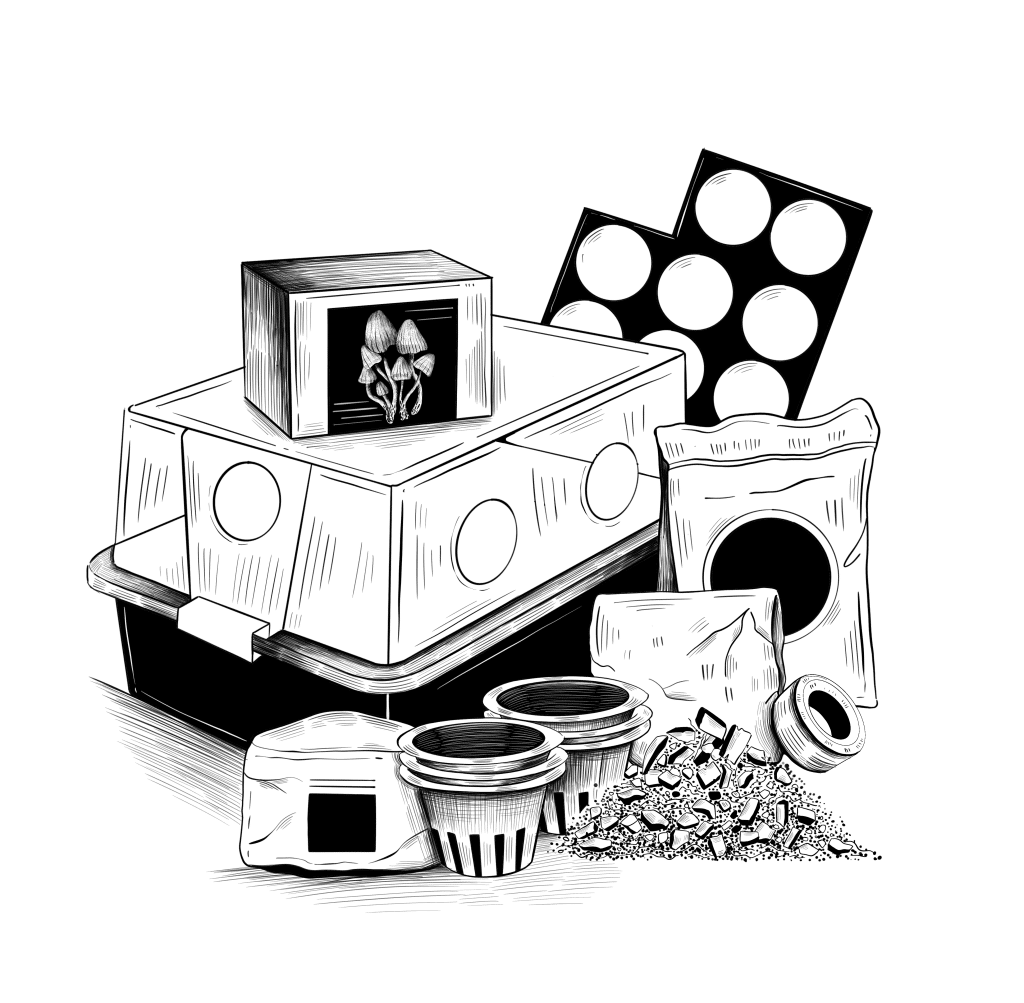
How to Cultivate Panaeolus cinctulus Mushrooms Indoors
Panaeolus cinctulus can be cultivated using a simple cultivation technique known as “PF Tek” (Psilocybe Fanaticus Technique). It’s not as easy to cultivate indoors as Psilocybe cubensis, but a cultivator with some experience should be able to have successful results.
PF Tek requires a series of glass jars filled with substrate. These are sterilized, inoculated with spores, incubated for two to three weeks, and then fruited in a simple fruiting chamber.
Panaeolus cinctulus grows best on straw or pasteurized manure. It prefers a slightly cooler incubation and fruiting environment and moderate to high humidity.
Learn how to cultivate this species using PF Tek: How to Grow Magic Mushrooms: The Easy Way
How to Cultivate Panaeolus cinctulus Mushrooms Outdoors
Panaeolus cinctulus is (surprisingly) easier to grow outdoors than indoors, provided the climate in the region is suitable for this species. These mushrooms grow in most climates, from temperate to subtropical — unless you live in a tropical or arctic environment, you should have success cultivating this species outdoors.
There are a couple of ways to grow Panaeolus cyanescens outdoors. The first involves collecting a sample from a colony in nature and “seeding” a mulch bed in your yard. The second way involves inoculating a substrate with spores and seeding a bed with the resulting mycelium.
The substrate in the bed isn’t essential, but it should be free-draining and packed with organic matter. I recommend a combination of deciduous woodchip, vermiculite, and compost.
Once the bed is seeded, keep it moist and free of weeds and (if possible) competing fungi. Cover the bed with a dark, breathable membrane to reduce the risk of competing plants and fungi growing in the area.
The bed should then be left undisturbed for two or three months, then remove the membrane. Mushrooms should begin to sprout when the temperature drops and conditions are suitable for fruiting. The bed will continue to fruit until the first frosts put the colony into a dormant state.
The mushroom bed should continue to fruit every year. Topping the bed with organic matter every year will ensure there are nutrients for the fungi to consume.
How to Prepare & Store Panaeolus cinctulus Mushrooms
Panaeolus cinctulus is a small species that doesn’t last particularly well when stored fresh. When stored in an open container or paper bag in the refrigerator, the mushrooms will stay fresh for two to three days before they turn bad.
To store them long-term, dehydrate them either by air-drying them or using a food dehydrator.
Due to their small size, Panaeolus cinctulus mushrooms can be placed on a sheet of greaseproof paper and left in a well-ventilated area. Turn them regularly to ensure even drying. The mushrooms should be completely dry after 24 to 48 hours.
You’ll know they’re dry enough to store when the stems and caps audibly “crack” when snapped or crushed. If they bend or feel squishy, leave them to dry further.
Using a food dehydrator is a much faster way to dry these mushrooms. Spread them evenly on the trays (without touching each other) and leave them at the lowest temperature for several hours until the mushrooms are cracker-dry.
Related: The Art & Science of Drying Magic Mushrooms: Your Step-by-Step Guide
Store the dry mushrooms in air-tight glass mason jars with a pack or two of a food-safe desiccant such as silica gel. This will ensure that any moisture remaining is absorbed.
Mushrooms dried and stored in this manner will last over a year before they begin to lose potency.
Ways to Take Panaeolus cinctulus
Due to how weak Panaeolus cinctulus mushrooms are, eating them whole is an inefficient means of consumption. It takes 5-7 grams of them to induce psychedelic effects — that’s quite a meal of some pretty foul-tasting mushrooms.
Whether you plan on consuming these mushrooms as microdoses or wish to achieve a psychedelic experience, there are far better ways to take P. cinctulus shrooms.
Here are a few consumption methods that are more effective than eating Panaeolus cinctulus mushrooms whole:
1. Making Magic Mushroom Capsules
Capsules make taking magic mushrooms tasteless, convenient, and discrete. They’re a great way to consume microdoses and easy to make.
All you need are some empty pill capsules and dried shrooms. Grind the mushrooms into a powder using a coffee grinder or food blender, split it into doses using a weighing scale, and stuff the powder into the empty pill capsules.
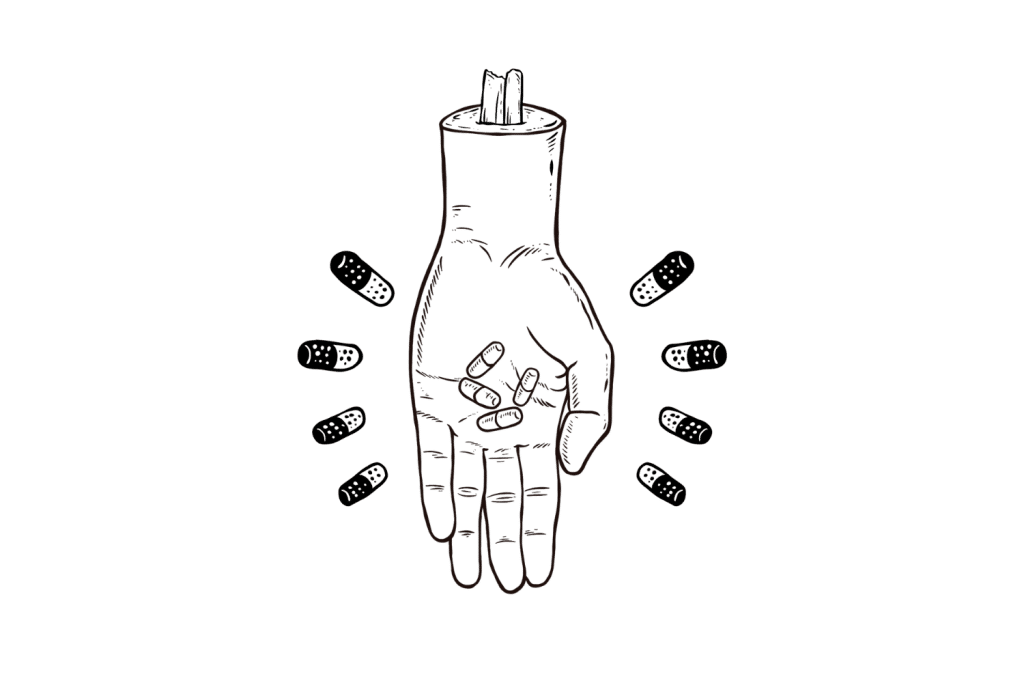
2. Making Magic Mushroom Tea
Magic mushroom tea is a good way to consume a psychedelic dose of Panaeolus cinctulus mushrooms. Tea eliminates the need to consume the organic part of the mushrooms — meaning you can take the active tryptamines without eating the actual mushrooms. This makes it easier on the taste buds and the digestive system while improving the onset time of the psilocybin.
Making tea is simple. Combine a dose of Panaeolus cinctulus with hot water in a thermal flask and leave it for 30 minutes to an hour. Then, strain the liquid and discard the organic matter.
The liquid will contain the dose of tryptamines that was in the mushrooms.
Learn how to make magic mushroom tea: How to Make Shroom Tea: Step-by-Step Guide
3. Making Psilocybin Gummies
Magic mushroom gummies eliminate the taste of magic mushrooms and can pack a punch in potency. With a low-potency species such as Panaeolus cinctulus, gummies allow you to concentrate the active psychedelic alkaloids, so it takes less organic matter to feel the effects.
Magic mushroom gummies can be purchased online, but the quality and tryptamine levels can be difficult to determine. Shroom gummies are easier than you may think to make at home. With a few pieces of basic equipment and some simple ingredients, it’s possible to make potent gummies from Panaeolus cinctulus — or any other magic mushroom species.
Related: How to Make Magic Mushroom Gummies: An Easy Vegan Recipe
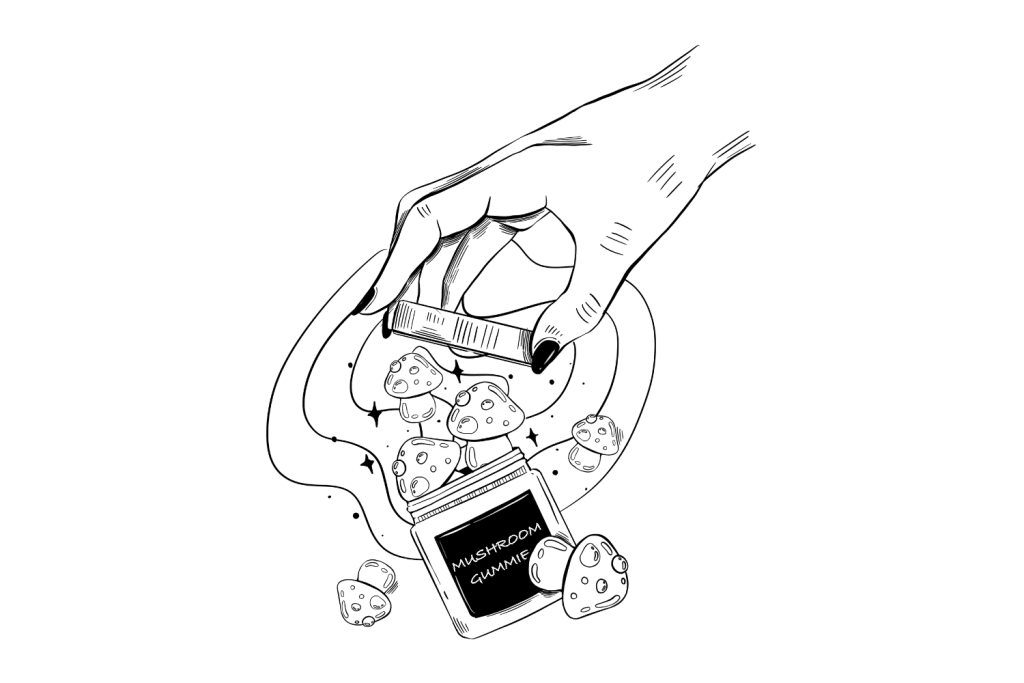
Are Panaeolus cinctulus Mushrooms Legal?
Although Panaeolus cinctulus mushrooms grow wild in several countries, they are illegal to collect, consume, and cultivate in most of them. The active psychedelic alkaloid present in these mushrooms is psilocybin, which is a controlled substance in most countries.
Possessing Panaeolus cinctulus or any other psilocybin-producing mushroom species in most Western countries can land you with hefty penalties — large fines, a criminal record, and, in some cases, prison time. That said, there are some exceptions to this.
Some countries within Europe, certain states in the United States, and areas throughout Canada have legalized or decriminalized psilocybin for certain applications or sit in a “legal gray area.”
Let’s find out more about the legality of these shrooms in a few different regions:
Canada
In Canada, psilocybin remains illegal. Therefore, the sale, possession, and consumption of Panaeolus cinctulus and other psilocybin-containing mushroom species are prohibited. Obtaining an exemption from Health Canada is possible if you have a “serious or life-threatening condition” that may be treatable with psilocybin. However, it doesn’t give many exemptions.
That said, Canada sits in a sort of legal gray area similar to how cannabis was before its legalization in 2018. Although psilocybin and other psychedelic substances are illegal, the laws aren’t usually enforced.
As with illegal cannabis dispensaries before 2018, Canada is home to several “magic mushroom shops” that openly sell shrooms and other psychedelic substances, making it easy to buy and consume psilocybin.
So, although magic mushrooms are technically illegal in Canada, their sale and use are tolerated by the government. Magic mushroom shops are rarely raided, and mushroom users are at little risk of facing legal repercussions — though there is still a risk. We expect Canada to move in a similar direction with psilocybin and other psychedelics as they did with cannabis back in 2018.
The United States
Psilocybin is federally illegal in the United States of America, but a selection of states have altered their laws state-wide or within certain municipalities. In some places, psilocybin mushrooms such as Panaeolus cinctulus have been decriminalized or legalized under certain circumstances.
The following states have altered their laws on psilocybin:
Although the states above have altered their laws surrounding psilocybin, the substance remains somewhat restricted. We’re yet to see a US state completely legalize psilocybin without restrictions for both medical and recreational consumption.
We will likely see the United States go in a similar direction to cannabis legalization, with states slowly but surely altering their psilocybin legislation until the substance becomes legal (mostly) country-wide.
Europe
Psilocybin and psilocybin-producing mushrooms remain mostly illegal in Europe. However, a few countries have a more liberal attitude toward the substance.
These countries have slightly different legislation surrounding psilocybin compared to the rest of Europe:
- The Netherlands: The sale and use of fresh psilocybin-containing truffles is legal and can be bought from a selection of “Smart Shops” nationwide. Psilocybin-containing mushrooms and dried truffles are illegal to sell and buy.
- Portugal: All drugs have been decriminalized, meaning that the possession and consumption of psilocybin mushrooms isn’t an offense. The sale of magic mushrooms remains illegal, and it’s still possible to face prosecution for the possession of larger amounts of any drug.
- Austria: Psilocybin mushrooms have been decriminalized and can be cultivated, provided they’re grown “without the intent of using them as a drug.”
With all that said, Panaeolus cinctulus and other magic mushroom spores are legal in most places, including the United States, Europe, and Canada. Spores can be purchased legally, but they’re illegal to cultivate in most regions.
Frequently Asked Questions
Now, I’ll answer a few common questions we receive.
1. What is the Difference Between “Strain” and “Species” In Magic Mushrooms?
The terms “species” and “strain” are thrown around a lot in the mushroom world. There are over 180 species of psychedelic mushrooms, some of which are made up of different strains.
A species is a genetically unique set of organisms in a genus. For example, Panaeolus cinctulus is a species of “Panaeolus.” Although part of the same broader family, it’s different from the species Panaeolus cyanescens of the same genus.
A strain is a genetic variation within a species. Psilocybe cubensis is made up of hundreds of different strains. Although these strains belong to the same species, they can exhibit differences in growth characteristics and tryptamine levels. Penis Envy looks and feels completely different from Golden Teacher, but they are of the same species — P. cubensis.
2. What’s the Most Potent Species of Psilocybin Mushroom?
The most potent species of psilocybin-producing mushroom is Psilocybe azurescens. This species can produce over 2.16% total tryptamines — 1.78% psilocybin and 0.38% psilocin.
Compared to the average strain of Psilocybe cubensis, P. azurescens is three to four times as potent.
3. What Does a Magic Mushroom Trip Feel Like?
The effects of psilocybin mushrooms can vary widely from one person to the next. Factors such as body weight, metabolism, and tolerance can alter how an individual experiences magic mushrooms. The dose, strength of the shrooms, and how much food the individual has eaten in the last 24 hours also influence the effects.
After consuming a psychedelic dose of psilocybin mushrooms, the individual can expect alterations in perception, such as changes in colors, shapes, and patterns. Some individuals may also experience “synesthesia” — where senses seem to cross, such as “hearing” colors or “seeing” sounds.
Mood may also be enhanced or elevated — many people describe intense waves of euphoria, ecstasy, and joy, as well as a profound connectedness with others and the world around them.
Magic mushrooms may also lead to deep self-reflection and introspection — this is why they’re effective in psychedelic-assisted psychotherapy. Individuals may gain insights into their personal experiences, thoughts, and emotions.
In higher doses, the individual may experience a dissolution of their sense of self, leading to a feeling of interconnectedness with the universe or a loss of the boundaries between oneself and the external world. This phenomenon is often referred to as ego dissolution or “ego death.”
4. Are “Magic Mushroom Gummies” Actually Made from Mushrooms?
Magic mushroom gummies are becoming more popular as the number of online shroom vendors grows. There’s no way to tell whether these gummies contain psilocybin from magic mushrooms without laboratory testing. However, some gummies seem more “legit” than others.
Related: Magic Mushroom Gummies Guide (All Psilocybin Gummies Ranked)
Some products sold as “magic mushroom” or “psilocybin” gummies may not contain any naturally occurring tryptamines. Some sketchy companies utilize research chemicals that closely mimic the effects of psilocybin. These chemicals can be potentially harmful.
Due to the lack of regulation for these products, they may also contain harmful contaminants and inaccurate doses of psilocybin or the corresponding research chemical.
If you buy magic mushroom gummies, do so from a trusted source. Or better, make them yourself.
Learn how to make magic mushroom gummies: How to Make Magic Mushroom Gummies: An Easy Vegan Recipe
Subscribe For More Psychedelics 🍄
References
- Berkeley, M. J., & Broome, C. E. (1861). Notices of British fungi (901–951). Ann. Mag. Nat. Hist, 7, 373-382.
- Murrill, W. A. (1916). A very dangerous mushroom. Mycologia, 8(3), 186-187.
- Watling, R. (1977). A Panaeolus poisoning in Scotland. Mycopathologia, 61(3), 187-190.
- Cavanna, F., Muller, S., de la Fuente, L. A., Zamberlan, F., Palmucci, M., Janeckova, L., … & Tagliazucchi, E. (2022). Microdosing with psilocybin mushrooms: a double-blind placebo-controlled study. Translational Psychiatry, 12(1), 307.

